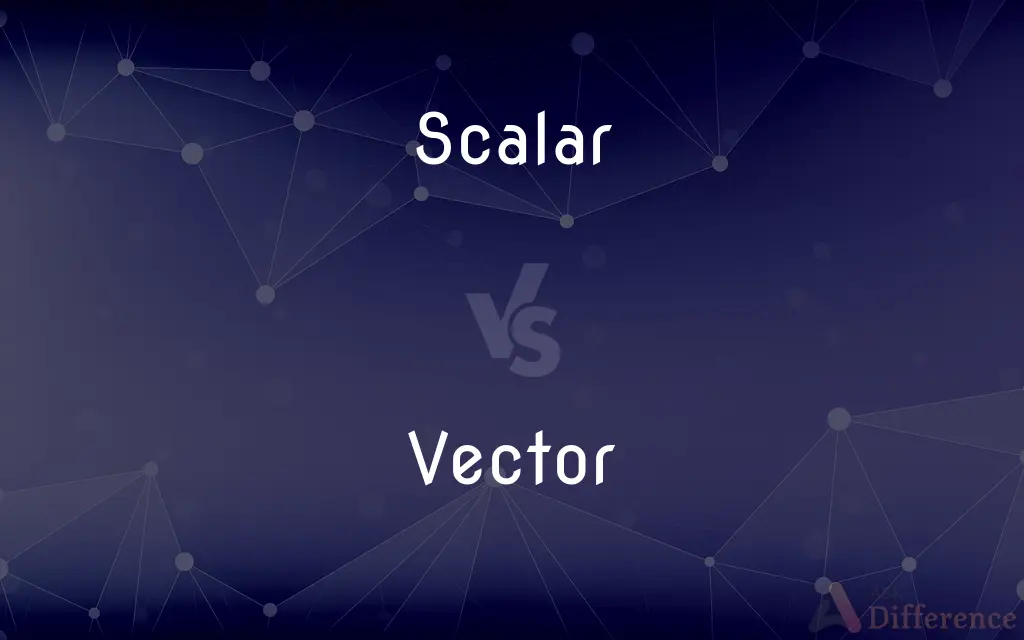Scalar vs. Vector — What's the Difference?
By Tayyaba Rehman — Updated on September 20, 2023
A scalar is a quantity that has magnitude only, such as temperature or speed. A vector, on the other hand, has both magnitude and direction, like velocity or force.

Difference Between Scalar and Vector
Table of Contents
ADVERTISEMENT
Key Differences
A scalar is a mathematical or physical quantity that is entirely described by its magnitude. It can be a real or complex number but doesn't have a direction. Vectors, however, are quantities that have both a magnitude and a specific direction in space. Scalars can be added, multiplied, and manipulated without considering any direction, while vectors require directional consideration.
Scalars are often simpler to handle because they involve just a single value. For instance, if you say the temperature is 75 degrees, you're dealing with a scalar quantity. In contrast, vectors involve more complexity; if you say the wind is blowing at 20 mph to the north, that's a vector quantity. You need both the speed (magnitude) and the direction (north) to fully describe the wind.
In mathematics and physics, operations on scalars and vectors are also different. Scalars can be added, subtracted, multiplied, or divided just like ordinary numbers. Vectors, on the other hand, require special rules for operations like addition and multiplication, which typically involve trigonometry or linear algebra techniques.
When graphed, a scalar may be represented as a point on a number line, while a vector is often represented by an arrow pointing in a particular direction. The length of the arrow indicates the vector's magnitude, while the arrow's direction indicates its direction. Therefore, the graphical representation of these two types of quantities is also different.
Comparison Chart
Definition
Quantity with magnitude only
Quantity with magnitude and direction
ADVERTISEMENT
Operations
Simple arithmetic
Requires linear algebra or trigonometry
Example
Temperature, Speed
Velocity, Force
Representation
Point on a number line
Arrow in space
Complexity
Simpler to handle
More complex due to direction
Compare with Definitions
Scalar
A real or complex number.
The number 5 is a scalar.
Vector
A quantity with both magnitude and direction.
Velocity is a vector because it involves both speed and direction.
Scalar
A quantity with magnitude only.
The distance between two cities is a scalar.
Vector
Subject to specialized mathematical rules.
Vectors are added using trigonometric methods.
Scalar
Subject to basic arithmetic operations.
Scalars can be added, like 3 + 2 = 5.
Vector
Utilized in various fields including physics and engineering.
In physics, force is treated as a vector.
Scalar
Lacks direction.
Temperature is a scalar because it doesn't have direction.
Vector
A quantity, such as velocity, completely specified by a magnitude and a direction.
Scalar
A quantity, such as mass, length, or speed, that is completely specified by its magnitude and has no direction.
Vector
A one-dimensional array.
Scalar
(Mathematics) A number, numerical quantity, or element in a field.
Vector
An element of a vector space.
Scalar
A device that yields an output equal to the input multiplied by a constant, as in a linear amplifier.
Vector
An organism, such as a mosquito or tick, that carries disease-causing microorganisms from one host to another.
Scalar
Of or relating to a scalar.
Vector
A bacteriophage, plasmid, or other agent that transfers genetic material from one cell to another.
Scalar
(mathematics) Having magnitude but not direction.
Vector
A force or influence.
Scalar
(computer science) Consisting of a single value (e.g. integer or string) rather than multiple values (e.g. array).
Vector
A course or direction, as of an airplane.
Scalar
Of, or relating to scale.
Vector
To guide (a pilot or aircraft, for example) by means of radio communication according to vectors.
Scalar
(music) Of or pertaining to a musical scale.
Vector
(mathematics) A directed quantity, one with both magnitude and direction; the signed difference between two points.
Scalar
(physics) Relating to particles with a spin quantum angular momentum of 0 (known as spin 0).
Vector
(mathematics) An ordered tuple representing such.
Scalar
(linguistics) Pertaining to the dimension on which something is measured.
Vector
(mathematics) Any member of a (generalized) vector space.
The vectors in are the single-variable polynomials with rational coefficients: one is .
Scalar
(mathematics) A quantity that has magnitude but not direction; compare vector.
Vector
(aviation) A chosen course or direction for motion, as of an aircraft.
Scalar
(electronics) An amplifier whose output is a constant multiple of its input.
Vector
(epidemiology) A carrier of a disease-causing agent.
Scalar
In the quaternion analysis, a quantity that has magnitude, but not direction; - distinguished from a vector, which has both magnitude and direction.
Vector
(sociology) A person or entity that passes along an urban legend or other meme.
Scalar
A variable quantity that cannot be resolved into components
Vector
(psychology) A recurring psychosocial issue that stimulates growth and development in the personality.
Scalar
Of or relating to a directionless magnitude;
Scalar implicatures
Vector
The way in which the eyes are drawn across the visual text. The trail that a book cover can encourage the eyes to follow from certain objects to others.en
Scalar
Represented as a point on a number line.
The scalar value of 4 can be shown as a single point on a number line.
Vector
A memory address containing the address of a code entry point, usually one which is part of a table and often one that is dereferenced and jumped to during the execution of an interrupt.
Vector
(programming) A one-dimensional array.
Vector
A graphical representation using outlines; vector graphics.
A vector image, vector graphics
Vector
(molecular biology) A DNA molecule used to carry genetic information from one organism into another.
Vector
To set (particularly an aircraft) on a course toward a selected point.
Vector
(computing) To redirect to a vector, or code entry point.
Vector
Same as Radius vector.
Vector
A directed quantity, as a straight line, a force, or a velocity. Vectors are said to be equal when their directions are the same and their magnitudes equal. Cf. Scalar.
Vector
A variable quantity that can be resolved into components
Vector
A straight line segment whose length is magnitude and whose orientation in space is direction
Vector
Any agent (person or animal or microorganism) that carries and transmits a disease;
Mosquitos are vectors of malaria and yellow fever
Fleas are vectors of the plague
Aphids are transmitters of plant diseases
When medical scientists talk about vectors they are usually talking about insects
Vector
Represented graphically by arrows.
A vector is often shown as an arrow pointing in a specific direction.
Vector
Has components.
A vector in 3D space might have i, j, and k components.
Common Curiosities
How do you add Scalars?
Scalars are added like regular numbers.
Is speed a Scalar or a Vector?
Speed is a scalar; it has no direction.
What is a Vector?
A vector is a quantity with both magnitude and direction.
Can Scalars be negative?
Yes, scalars can be negative, positive, or zero.
How do you add Vectors?
Vectors are added using trigonometric or geometric methods.
Can Scalars be complex numbers?
Yes, scalars can be real or complex numbers.
What is a Scalar?
A scalar is a quantity that only has magnitude.
Can Vectors be negative?
Vectors can have negative components, indicating opposite direction.
What fields commonly use Scalars?
Scalars are used in mathematics, physics, engineering, and many other fields.
Is velocity a Scalar or a Vector?
Velocity is a vector; it has both speed and direction.
How are Scalars represented graphically?
Scalars can be represented as points on a number line.
Do Vectors have components?
Yes, vectors have components that define their magnitude and direction.
What fields commonly use Vectors?
Vectors are used in physics, engineering, computer graphics, and more.
Can Vectors become Scalars?
Vectors can be reduced to scalars through operations like dot product.
How are Vectors represented graphically?
Vectors are represented as arrows in space.
Share Your Discovery

Previous Comparison
Sieve vs. Strainer
Next Comparison
Snowstorm vs. BlizzardAuthor Spotlight
Written by
Tayyaba RehmanTayyaba Rehman is a distinguished writer, currently serving as a primary contributor to askdifference.com. As a researcher in semantics and etymology, Tayyaba's passion for the complexity of languages and their distinctions has found a perfect home on the platform. Tayyaba delves into the intricacies of language, distinguishing between commonly confused words and phrases, thereby providing clarity for readers worldwide.














































